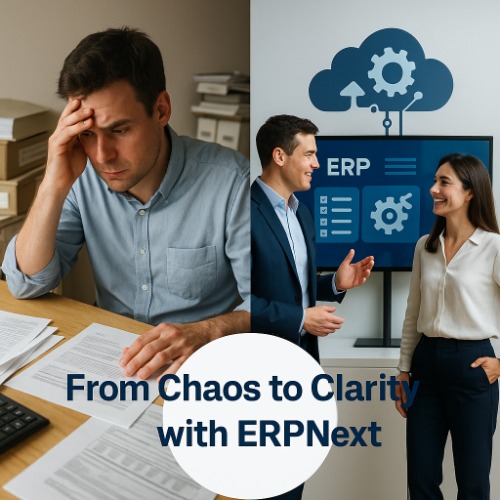Transform Your Business with ERPNext: From Manual to Automated
Introduction: A New Era of Operational Excellence
In the evolving world of modern enterprise, efficiency is the currency of competitiveness. Organizations striving for sustainability and growth must embrace smart digital tools that not only manage daily operations but automate repetitive workflows, minimize human error, and enable data-driven decisions. This is where ERPNext, an advanced open-source ERP system, proves invaluable.
Built on the robust Frappe Framework, ERPNext provides a unified solution that connects various departments—from finance and sales to inventory, HR, and project management—into one intelligent system. This blog delves deep into how ERPNext enhances business efficiency by automating key processes and why it has become a go-to solution for forward-thinking organizations.
Understanding ERPNext: A Smart Choice for Growing Businesses
ERPNext is a full-featured enterprise resource planning platform that simplifies complex business operations. Designed especially for small to medium-sized enterprises (SMEs), it is modular, scalable, cloud-ready, and highly customisation. With an intuitive user interface and wide-ranging functionalities, ERPNext helps organisations centralise their data, enforce consistency, and streamline processes—all while reducing operational overhead.
Whether you’re a manufacturing unit, retail chain, educational institution, or service provider, ERPNext caters to a wide variety of industries, helping businesses manage core functions through automation and intelligent reporting.
Why Business Process Automation Matters More Than Ever :
Automation has moved from being a luxury to a critical success factor. In today’s highly dynamic and fast-paced business environment, automation offers a range of strategic advantages:
- Reduces Operational Overhead: Automating routine tasks eliminates redundant processes and labor costs.
- Improves Process Accuracy: It ensures fewer errors in financial reporting, inventory tracking, and compliance.
- Accelerates Turnaround Time: Faster approvals, quicker order processing, and real-time communication enhance agility.
- Supports Informed Decision-Making: With real-time dashboards and automated reporting, business leaders can act proactively.
- Increases Customer Satisfaction: Timely deliveries, accurate invoicing, and faster service responses lead to better customer experiences.
- Scalable Operations: Automation prepares the business for growth without proportionally increasing the resource requirements.
Core Business Functions Automated by ERPNext :
Let’s explore how ERPNext systematically automates each essential department within an organization:
1. Finance & Accounting Automation :
ERPNext automates complex accounting operations by offering:
- Automated invoice generation with pre-configured templates.
- Real-time general ledger updates and auto-posting of entries.
- Integration with bank feeds and automatic bank reconciliation.
- Tax calculations, filing assistance, and audit trails.
- Automated financial statements and budget reports.
Result: Reduced manual intervention, faster month-end closures, and enhanced financial transparency.
2. Inventory & Warehouse Management :
ERPNext brings automation to inventory control through:
- Real-time stock tracking across multiple warehouses.
- Automated reorder levels with purchase trigger alerts.
- Batch tracking and expiry management.
- Seamless barcode integration for stock movement.
- Stock valuation, reports, and inventory forecasting.
Result: Improved stock accuracy, reduced inventory holding costs, and zero stockouts.
3. Sales & CRM Workflows :
ERPNext transforms the sales cycle with end-to-end automation:
- Auto-generation of quotations and sales orders from leads.
- Configurable pricing rules, discounts, and tax templates.
- Pipeline visibility with reminders and next-action triggers.
- Email/SMS communication logs and automated follow-ups.
- Sales analytics dashboards for performance monitoring.
Result: Faster sales cycles, improved lead conversion rates, and enhanced customer relationships.
4. Procurement & Supplier Management :
Streamline procurement processes with:
- Automated supplier quotation requests and comparisons.
- Dynamic purchase order generation based on stock levels.
- Purchase invoicing and payment tracking.
- Supplier performance metrics and cost analysis reports.
- Workflow approvals for budgeting and compliance.
Result: Smarter purchasing, reduced procurement delays, and stronger vendor partnerships.
5. Human Resources (HR) Automation :
ERPNext simplifies and digitizes HR processes with features such as:
- Employee onboarding/offboarding workflows.
- Biometric or manual attendance integration.
- Payroll automation with statutory compliance.
- Leave requests, approval flows, and holiday calendars.
- Performance management and appraisal automation.
Result: Better employee engagement, reduced HR overhead, and accurate payroll processing.
6. Project and Task Automation :
With ERPNext, project managers can:
- Automatically assign tasks based on templates or triggers.
- Visualize project timelines with Gantt charts and Kanban views.
- Link timesheets and billing directly to projects.
- Monitor budgets and actuals in real time.
- Generate task progress and milestone achievement reports.
Result: Higher project visibility, on-time delivery, and reduced resource leakage.
Key Benefits of Process Automation Using ERPNext :
ERPNext offers a strategic advantage by bringing together automation and integration under one umbrella. The benefits include:
- Centralised Data Architecture: A single source of truth eliminates silos and promotes collaboration.
- Customisation Workflows: Businesses can define rules, conditions, and automation without any coding.
- Cost-Effective Deployment: As a free and open-source ERP, ERPNext significantly reduces licensing and operational costs.
- Multi-Device Accessibility: Cloud-based and mobile-friendly for on-the-go business management.
- Comprehensive Reporting: Every module includes configurable dashboards and analytics to support data-driven decision-making.
Real-World Example: Manufacturing Industry Transformation
A medium-sized industrial manufacturer faced issues with delayed order fulfillment and inconsistent inventory data. After implementing ERPNext:
- Manual data entry reduced by over 50%.
- Inventory accuracy improved by 35%.
- On-time delivery rate rose by 40%.
- Purchase approvals were automated, cutting down approval time from 3 days to 6 hours.
- Financial reconciliation time was slashed by 60%.
This transformation demonstrates how ERPNext’s automation capabilities can directly impact operational efficiency and customer satisfaction.
Getting Started: Steps Toward Automation with ERPNext
Implementing ERPNext successfully involves:
- Process Audit: Evaluate current operations and identify pain points.
- Module Selection: Choose only the modules relevant to your industry and scale.
- Workflow Design: Create customised workflows and rules to automate processes.
- User Training: Ensure your team is well-versed in ERPNext’s capabilities.
- Feedback & Optimisation: Continuously refine workflows based on usage insights.
Conclusion: Future-Ready Your Business with ERPNext
Automation is no longer an add-on; it is a core driver of business success. ERPNext empowers businesses to achieve operational excellence by automating redundant processes, streamlining workflows, and fostering data transparency across all departments. Whether you’re scaling up, optimizing performance, or enhancing customer experiences, ERPNext provides the digital backbone needed to succeed.By embracing ERPNext, organizations not only gain efficiency but also position themselves to grow smarter, faster, and more sustainably.


